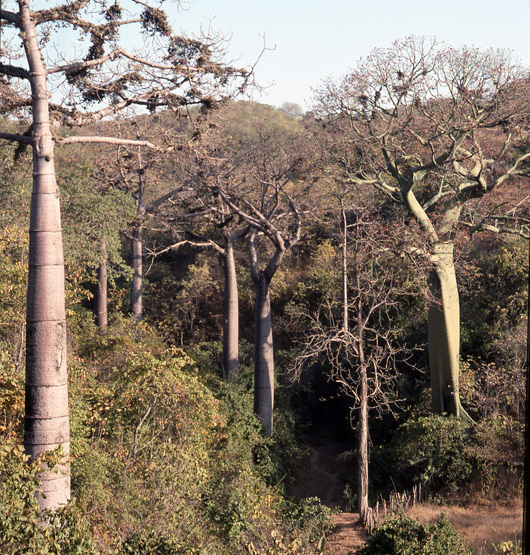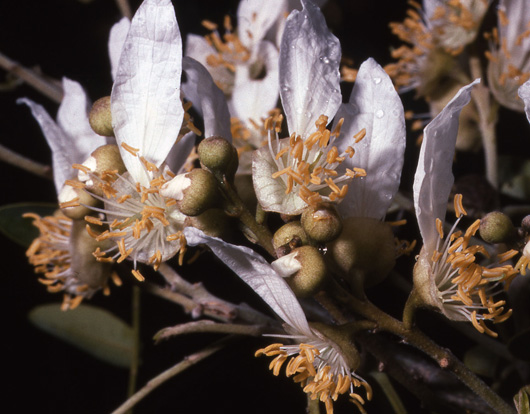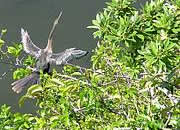South America: Re-writing the history of Andean Dry Forests
24.09.10
Scientists from some of the world’s most prestigious botanical institutions have re-written the history of the extraordinary Andean Dry Forests and in the process helped set an agenda to safeguard their future.
The Tropical Andes Biodiversity Hotspot is probably the richest of all the Hotspots but historically much of the conservation attention has been paid to other Andean biomes, such as rainforest, cloud forest, and páramo (scrub and wetlands between upper forest line and permanent snow line).
So Prof. Toby Pennington, from Royal Botanic Gardens Edinburgh (RBGE), assembled a team to study the greatly disturbed Andean Dry Forest systems. Their findings were extraordinary.
“Dry forests are the most threatened tropical forests on the planet, but have been drastically understudied compared to rainforests. The ultimate aim of the paper is to raise the conservation profile of these dry forests in the Andes where they are in urgent need of protection,” said Pennington.

Ancient Andean Dry Forest has long been ignored by the conservation community.
© Gwilym Lewis, RBG Kew
During the project the team discovered that the leguminous shrub species Cyathostegia mathewsii is more than 10 million years old and populations, found in four separate valleys in Ecuador and Peru, have been isolated from each other for millions of years. The stability of the dry forests over the past 10 million years, during which the dynamic mountain uplift events and historical climate changes have taken place in the Andes, seems remarkable, according to Pennington. The long evolutionary history of these dry forests is in stark contrast to other Andean vegetation types which are more recent in age. The fact these Andean dry forests contain a living “museum” of diversity highlights the urgent need for protection.
Tiina Sarkinen has also shown, in her PhD studies, that the longevity of the genus Cyathostegia is not exceptional, but that a number of other plants in Andean dry forests have also been present for millions of years.

The white flowers of Cyathostegia mathewsii - the subject of much of the study. It was discovered populations of Cyathostegia have been isolated for many millions of years.
© Gwilym Lewis, RBG Kew
“The data show clearly that the dry forests have a long history in contrast to the other vegetation types in the Andes,” Sarkinen said. “Our studies are the first steps in understanding the true diversity of the forests, but we still need baseline data such as complete species lists for these forests. More than a third of the plants occur nowhere else on the planet and we continue to discover new species every field trip”.
This research partnership between RBG Kew and RBGE dates back to 1991 when Toby Pennington was trained, during his PhD fieldwork, by Gwilym Lewis in Brazil.
They have since collaborated at various levels, including in 1997 when Gwilym and Bente Klitgaard, who were working on dry forests in Ecuador, invited Toby and Dr Vanessa Plana to participate in fieldwork. This was the first time Toby saw the Cyathostegia mathewsii which is the subject of the PNAS paper: “We knew this to be an interesting plant. It was thought to be very restricted and confined to south Ecuador and north Peru, but we later discovered populations in two other dry valleys.”
Pennington confirmed the significance of such partnerships on international conservation: “Understanding plant diversity is a challenge in the Tropics, where most species occur – there are 45,000 species of plants in the Andes alone. We work together with experts from the Universidad Nacional Agraria La Molina in Lima, Peru, and our aim is that our collaborative study brings these unique forests to the global map of conservation priorities”.
Other collaborators in the project were Dr. Colin Hughes (University of Oxford), Dr. Gwilym Lewis (RBG Kew), Dr. Bente Klitgaard (RBG Kew) and Prof. Matt Lavin (Montana State University).
Related links:
Contrasting plant diversification histories within the Andean biodiversity hotspot
Brazil: Magagascan rainforest and the Everglades 'at risk'
06.08.10
 Following the recommendations of IUCN (International Union for Conservation of Nature), important rainforest areas in Madagascar and the Everglades National Park (USA) have been added to the List of World Heritage in Danger at the World Heritage annual meeting, which took place recently in Brasilia.
Following the recommendations of IUCN (International Union for Conservation of Nature), important rainforest areas in Madagascar and the Everglades National Park (USA) have been added to the List of World Heritage in Danger at the World Heritage annual meeting, which took place recently in Brasilia.
Ecuador: Historic $3.6 bn deal keeps rainforest above the oil
05.08.10
An ambitious international trust fund negotiated between Ecuador and the United Nations Development Fund (UNDP) could pave the way for an exciting new set of projects to protect global rainforests.
Ecuador: Yasuni - the most biodiverse place on Earth?
22.01.10
A study published in the open access journal Plos One has revealed extraordinary species richness in the western Amazon covering eastern Ecuador and northern Peru.
Chile: A Chilean conservation adventure
13.11.09
 Smoking volcanoes, devastated towns, leech infested forests, endless breathtaking landscapes, and the beautiful but often highly endangered plant species of South America greeted the team from Wakehurst Place, Kew’s country estate in West Sussex, the Forestry Commission's Bedgebury Pinetum and Westonbirt Arboretum.
Smoking volcanoes, devastated towns, leech infested forests, endless breathtaking landscapes, and the beautiful but often highly endangered plant species of South America greeted the team from Wakehurst Place, Kew’s country estate in West Sussex, the Forestry Commission's Bedgebury Pinetum and Westonbirt Arboretum.